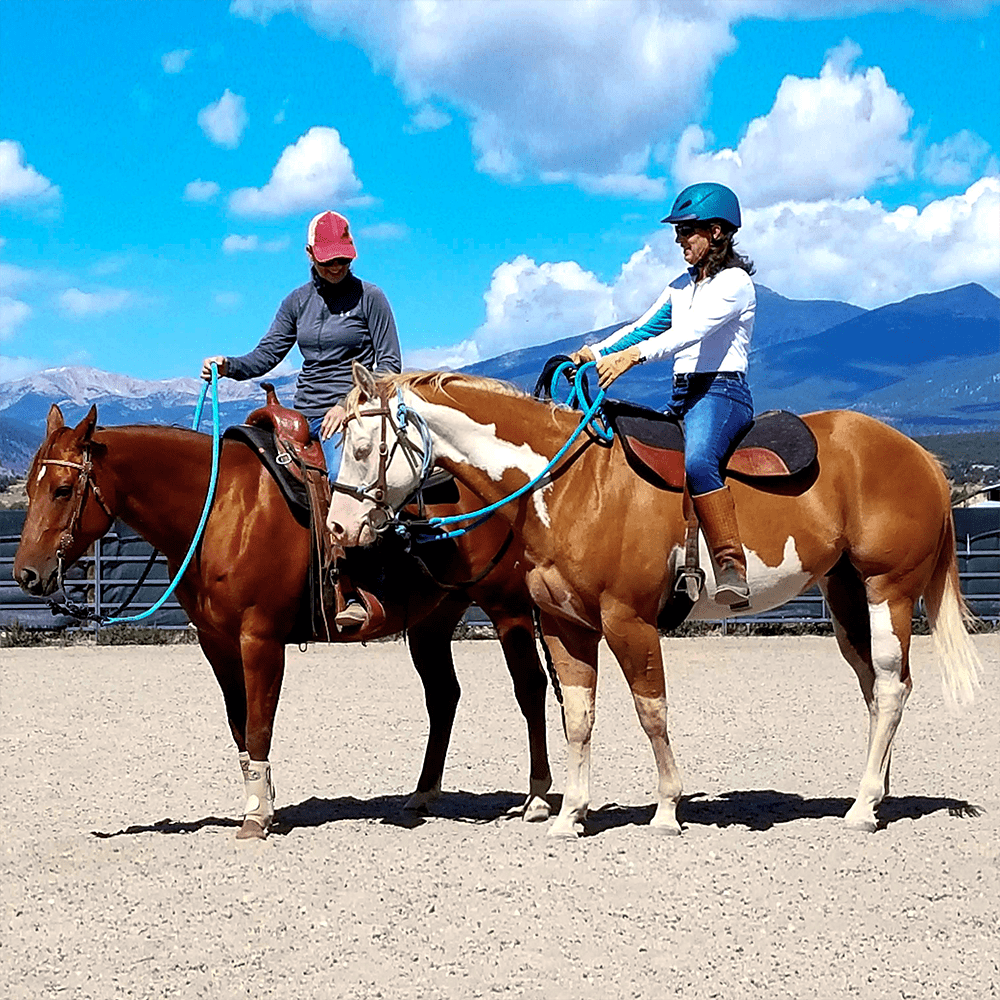The Trail Rider ~ May 2016
Ride Right with Julie Goodnight
The Pulley-Rein Stop
Learn how to stop a bolting horse on a narrow trail using a pulley rein with top trainer/clinician Julie Goodnight’s four-step technique.
By Julie Goodnight with Heidi Melocco
If you’ve had an accident, need a confidence boost, or ride on narrow trails, it’s important to know the pulley-rein stop. Read on to learn Julie Goodnight’s four-step technique.
Have you ever ridden a horse that spooked and bolted — and was ready to run fast and far? Bolting is a normal part of a horse’s flight response after he’s spooked. To safely control a spooked horse, you have a fraction of a second to choose your cues.
You might be familiar with the one-rein stop, in which you use one rein to turn and stop. For how to perform the one-rein stop, look at this article in my Academy. Emergency Stop: Rein Aids That Keep You Safe
However, if you’re on a narrow trail with no room to turn, or the horse is truly running away with you it might be best to employ the pulley-rein stop.
You won’t use this extreme stopping cue as an everyday method to halt your horse, like you would the one-rein stop, but in an emergency, with nowhere to turn, it just may save your life.
“There’s a distinct difference in an emergency and a horse that just goes a little bit too fast,” says top trainer/clinician Julie Goodnight. “Don’t use the pulley-rein stop when your horse is just going faster than you’d like. The one-rein stop is for that.
“To me, an emergency is when the horse is out of control, or the rider has lost her balance, and someone is in danger of getting hurt. If you need a last-resort way to stop, knowing the pulley rein can help you stop any horse — no matter your size or the horse’s size.”
Goodnight says most riders are first taught to sit back and apply backward rein pressure to stop. This technique can be fine if your horse just needs to slow down. But if your horse is bucking and running off, simply pulling back isn’t going to stop him. A horse that’s running off may brace his neck, pull back against you, grab the bit, and continue to run off in response to your two-handed pull.
“You can’t win a tug of war with a 1,000-pound horse,” notes Goodnight. “The horse will ‘run through’ bit pressure alone if he’s panicked and bolting.”
And, as noted, the one-rein stop isn’t always the best option if it’ll cause your runaway horse to lose his balance and fall, or if you’re on a narrow trail.
“With practice, you can teach your horse to stop off one rein without turning,” says Goodnight. “But on the trail, you might not want to take the chance the horse won’t turn, especially when stopping promptly is critical.”
If you’ve had an accident, need a confidence boost, or ride on narrow trails, it’s important to know the pulley-rein stop. No stopping technique will work in every single emergency situation, but it’ll boost your confidence to know that you’ll likely be able to stop any horse, when you master this skill.
Before You Begin
Practicing the pulley-rein stop can be hard on your horse, because you’ll pull on the mouth to stop him. So you’ll practice this technique while you’re sitting still on your horse’s back. In this way, you’ll learn the motions without pulling hard or at all. You do need to practice on your horse, as your hands need to be in a specific position on his neck.
“After you know the hand movements, you can move out into an open space where any horse may feel strong — especially when pointed back toward the barn,” says Goodnight. “Make sure you’re not being excessively hard on your horse and are only practicing enough to memorize the hand movements.”
Before you begin, don an ASTM-approved, SEI-certified riding helmet. Tack up your horse in his usual bridle and saddle. Find an enclosed area with good footing. Mount up, and take a rein in each hand.
Step 1. Shorten the First Rein
Riding with two reins, put your hands out in front of you. You can choose which hand moves first, but for illustration purposes, we’ll start with the left hand. Shorten the left rein by sliding your hand down until the rein is quite short. With your right hand, hold the rest of the reins (if you’re riding with loop reins) or the opposite rein (if you’re riding with split reins).
Caveat: Be sure to shorten the left rein enough to stop your horse from turning his nose right when you pull the right rein. Also be sure you position your hand directly over his neck. If you don’t, he’ll pull your hand to the side. You must be centered so that you have a place to push into his neck.
Step 2. Plant your Hand
With your shortened rein in your left hand, push your knuckles down into the center of your horse’s mane, at the notch just above his withers. Your left hand will stay braced against your horse and will continue to push into his neck. Imagine that this arm is the forward hand if you were holding a bow and arrow. It pushes forward and keeps your horse from turning his head.
Step 3. Shorten the Second Rein
Using your left thumb, grab the tail of the right rein, and slide your right hand down the rein. With your left hand, keep pushing forward into your horse’s mane .
Step 4. Pull Back and Sit Back
Pull back and up with your right rein while your left arm pushes into the neck. Your arms must work in opposition with each other. Pull back with your right hand like an archer pulls a bow just before she shoots it; at the same time, brace into the neck with your left arm to create opposition.
As you pick up and back with your right hand, sit back with your whole body weight. If you’re using this aid, you’re in an emergency situation, and you need to put your whole body weight into the stop.
When your horse stops, release the cue immediately. Otherwise, he may backup, rear or even go over backward.
Caveat: Don’t pull the left rein while also pulling the right rein. You must keep pushing in the left rein and pulling back on the right rein.
Practicing the pulley rein is hard on your horse, so only practice to learn the moves and don’t apply full force. Be gentle, and don’t practice often. When you get it right, you’ll immediately feel the power you have. You’ll boost your confidence when riding in open spaces or on unfamiliar horses as you have the means to stop a horse in an emergency.
For more information on equine behavior, including how to perform the one-rein stop, see Goodnight’s Guide to Great Trail Riding, with bonus DVD, available from Julie’s shop: https://shop.juliegoodnight.com/product/goodnights-guide-to-great-trail-riding/
SIDEBAR
The Emergency Dismount
When should you stay on and stop your horse with the pulley rein versus dismounting and getting out of harm’s way?
The risk of injury to the rider makes the emergency dismount a questionable skill for some to practice. Jumping from a horse can cause sprained ankles or falls. While children love to learn this skill while jumping from short ponies, those with joint pain may find practice difficult or dangerous.
Julie Goodnight says that on the trail, it’s often safer to stay on your horse than to dismount onto unknown footing. However, she feels the emergency dismount is a key skill to learn, as there may be an instance where dismounting is safer than staying with your horse.
“Only jump off your horse when it’s safer to jump off than stay on,” says Goodnight. “An example might be if your horse is running off with you and heading toward a barbed-wire fence or cliff.
“I put the pulley rein and the emergency dismount in the category of ‘good to know, good to practice, hope you never need to use it.’ ”
Here’s how to perform the emergency dismount. For safety, wear an ASTM-approved, SEI-certified riding helmet, and consider practicing on a vaulting dummy or a stack of hay bales. Practice the rhythm of the dismount, so you’ll know exactly what to do and in what order.
Step 1. Kick your feet out of the stirrups. That seems obvious, but it’s not your first instinct when you’re panicking.
Step 2. Place your hands on the saddle’s pommel or on your horse’s neck. If you’re riding in a Western saddle, place your right hand behind the horn to shield your stomach from the horn.
Step 3. Release the reins, and kick your right leg high up and over the saddle’s cantle as you push off with your hands. If your horse is out of control and you’re dismounting, you don’t need to hold on. Plus, holding onto the reins while dismounting could cause him to fall on you as you land. As you vault off, be careful not to kick him in the back.
Step 4. Swing your legs together, and land facing forward with your knees bent. The more you can move in a sweeping, athletic, flexed vault, the more likely you are to land on your feet without pain.

